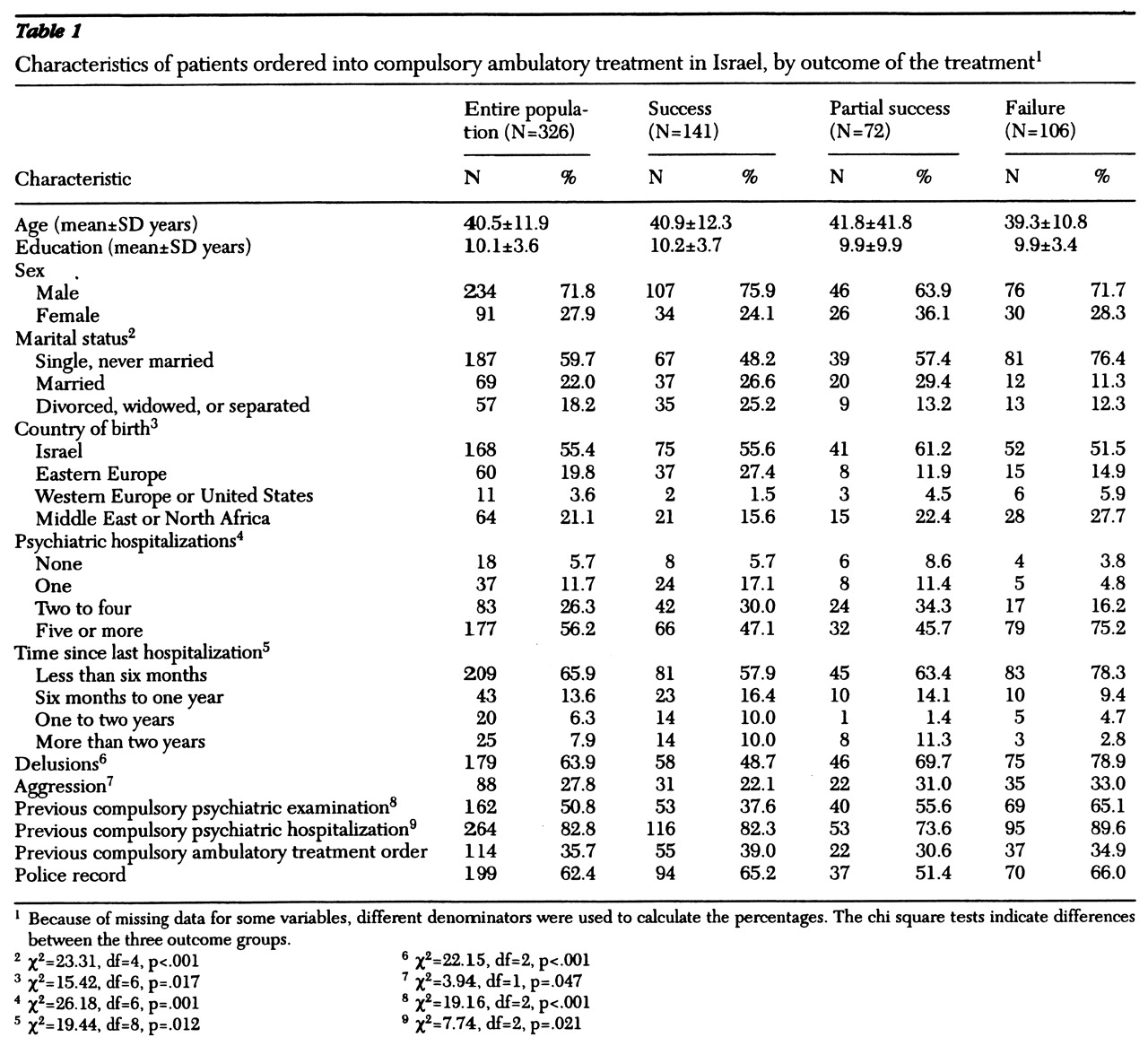Until 1991 compulsory psychiatric treatment in Israel was possible only in the framework of full hospitalization. According to the Treatment of Mental Patients Law of 1991(
1), a district psychiatrist is entitled, after a psychiatric examination, to order compulsory ambulatory treatment. The patient is assigned to a designated clinic, under specified conditions, for a period not exceeding six months, with the possibility of six-month extensions. The intention of this measure was to achieve a balance between civil liberties and treatment needs and between forced confinement and dangerousness or self-neglect due to nontreatment.
The notion of compulsory ambulatory treatment, introduced by Bleicher (
2) in 1967, gathered momentum in the 1970s and 1980s. It was accommodated in the framework of the law in various parts of the United States—first, in the form of conditional discharge, then as an order for compulsory ambulatory treatment requiring court ratification. Only later were clear criteria established for such orders (
3).
Orders for compulsory ambulatory treatment in Israel and the United States are somewhat different (
4). In Israel the authority for decision making is a district psychiatrist, whereas in the U.S. it is a court of law. The duration of compulsory ambulatory treatment is for up to six months in Israel and from one year to an indeterminate period in some states. In both Israel and the U.S., noncompliance with the terms of the order results in compulsory hospitalization. In Israel the criteria for compulsory ambulatory treatment and compulsory hospitalization are identical, whereas in the U.S. the criteria for compulsory ambulatory treatment in some states are less restrictive than those for compulsory hospitalization.
Attempts to assess the efficacy of compulsory ambulatory treatment orders have produced conflicting results (
5). Band and associates (
6) observed that the threat of compulsory hospitalization enhanced compliance, preempted hospitalization, reduced readmission rates, and attenuated the length of hospitalizations. In addition to enhanced compliance, Geller (
7) reported an increased tendency for patients to undertake treatment voluntarily. Disappointing results have also been reported, such as findings that compulsory ambulatory treatment had no significant effect on critical measures (
8), and even findings of an increase in the rate of repeat hospitalizations (
9).
A preliminary survey of the effect of compulsory ambulatory treatment orders conducted in the Jerusalem district in the first year after implementation produced somewhat disappointing results (
10). The study reported here was undertaken with a larger sample to evaluate compulsory ambulatory treatment orders in Israel and the factors that might account for their success or failure.
Methods
The study was a retrospective survey. Patients in compulsory ambulatory treatment were identified from lists of the district psychiatrists. Additional information was obtained from patients' hospital and outpatient clinic records.
The research population was divided into three outcome groups based on success, partial success, and failure. Success was defined as continuous treatment for the entire six-month period of compulsory ambulatory treatment, or as voluntary hospitalization during or after the compulsory ambulatory treatment period. Failure was defined as the need for compulsory hospitalization during, and in spite of, compulsory ambulatory treatment. Partial success was defined as the inability to conform to the terms of the compulsory ambulatory treatment order but without the need for compulsory hospitalization. The three outcome groups were compared in an attempt to identify the population most likely to benefit from compulsory ambulatory treatment.
Results
During the first four years of the new Treatment of Mental Patients Law, 326 orders for compulsory ambulatory treatment were served on 208 patients in the Jerusalem and Southern districts of Israel. The districts have populations of 646,100 and 734,800, respectively. During the same period, 5,364 orders for compulsory hospitalization were issued, for a ratio of 16.45 compulsory hospitalization orders for every compulsory ambulatory treatment order.
Table 1 presents demographic, clinical, and legal information about the research population by outcome group. In 141 of the 326 cases (43.3 percent) patients had successful outcomes. Failure, defined in terms of the need for compulsory hospitalization during the ambulatory treatment period, occurred in 106 cases (32.5 percent). Partial success was indicated in 72 cases (22.1 percent). In seven cases the outcome was unclear.
Most of the patients in compulsory ambulatory treatment were diagnosed as having schizophrenia (222 cases, or 68.1 percent), followed by schizoaffective disorder (49 cases, or 15 percent), psychoses of organic origin (21 cases, or 6.4 percent), affective disorders (eight cases, or 2.5 percent), personality disorders including antisocial disturbances (seven cases, or 2.1 percent), and no clear-cut diagnosis (17 cases, or 5.2 percent). No significant relationship was found between clinical diagnosis and outcome group.
In 112 of the 326 cases (34.4 percent) the patients in compulsory ambulatory treatment had received regular psychiatric treatment before the compulsory ambulatory treatment order, and more than half had received sporadic treatment. In 32 cases (9.8 percent) the patients had never undergone psychiatric treatment. The majority of the patients in compulsory ambulatory treatment were treated with depot neuroleptics or a combination of depot and oral medications. No statistical correlation was found between treatment mode and outcome.
A relationship was found between the number of previous hospitalizations and the outcome of compulsory ambulatory treatment. Patients who had one previous hospitalization were the most likely to have a successful outcome; they were even more likely to have a successful outcome than patients with no previous hospitalizations. Beyond one previous hospitalization, the greater the number of hospitalizations, the lower the success rate.
The length of time since the last hospitalization also had a bearing on success or failure. The longer the time since the last hospitalization—up to two years—the higher the success rate. Beyond two years, the efficacy of compulsory ambulatory treatment appeared to decrease.
Patients with successful outcomes were significantly less aggressive than patients in the other two groups, and delusions were less prevalent in the successful-outcome group. No relationship was found between outcome and insight, judgment, or affect. The success rate was inversely related to previous compulsory hospitalizations and compulsory examinations.
In 201 of the 326 cases (61.7 percent) the patients were fully cooperative with the compulsory ambulatory treatment order; in 95 cases (29.1 percent) patients needed the help of their families to comply with the order. Appeals of the order occurred in only five cases.
In 67 of the 326 cases (20.6 percent), patients continued treatment on a voluntary basis after the compulsory ambulatory treatment period. In 52 cases (16 percent), patients were served with an additional six-month order, and in 22 cases (6.7 percent), patients agreed to voluntary hospitalization. These results were considered encouraging and defined as successful.
Discussion and conclusions
In Israel the order for compulsory ambulatory treatment is based on criteria similar to the order for compulsory hospitalization and the need for urgent or nonurgent compulsory examination. The target population for compulsory ambulatory treatment includes patients with illnesses in the psychotic spectrum (mainly schizophrenia and affective disorders), patients not cognizant of their illness who do not comply with treatment, patients in need of an external framework but unable to create a treatment structure on their own, patients responsive to medications such as long-term injections and amenable to monitoring such as blood tests, patients with the capacity to understand the compulsory ambulatory treatment procedure who wish to live in the community, and patients with a degree of insight who are amenable to reasoned persuasion and are motivated to comply with treatment.
The results obtained in the study are encouraging. Compulsory ambulatory treatment was defined as successful in 43.3 percent of the cases. Patients with successful outcomes cooperated with the treatment facility to which they were assigned and either continued to receive compulsory outpatient treatment or agreed to be hospitalized voluntarily. Thus compulsory ambulatory treatment was clearly an important tool in preventing compulsory hospitalization. It provides patients with a treatment alternative, which, although it involves some constraints on personal freedom, is much less restrictive than compulsory hospitalization.
Compulsory ambulatory treatment failed to prevent compulsory hospitalization in 32.5 percent of the cases. The main reasons that compulsory ambulatory treatment is ineffective or underutilized are lack of clear differentiation in the law between the criteria for compulsory ambulatory treatment and compulsory hospitalization, inadequate infrastructure and resources for monitoring and enforcement, and insufficient knowledge about compulsory ambulatory treatment among mental health professionals. It is also our impression that community mental health personnel are reluctant to see patients in compulsory ambulatory treatment because such patients are likely to be particularly difficult, and the notion of coercion runs counter to the rationale underlying community treatment.
Our results indicate that compulsory ambulatory treatment is an effective tool for the prevention of compulsory hospitalization. However, improved means and resources for its implementation need to be developed. The sanction of compulsory hospitalization for noncompliance with the terms of the order that is contained in the law is not an adequate deterrent, nor is it resorted to in most cases. We believe that improvement in these areas will bring future results more in line with the original hopes and expectations for the compulsory ambulatory treatment order.


